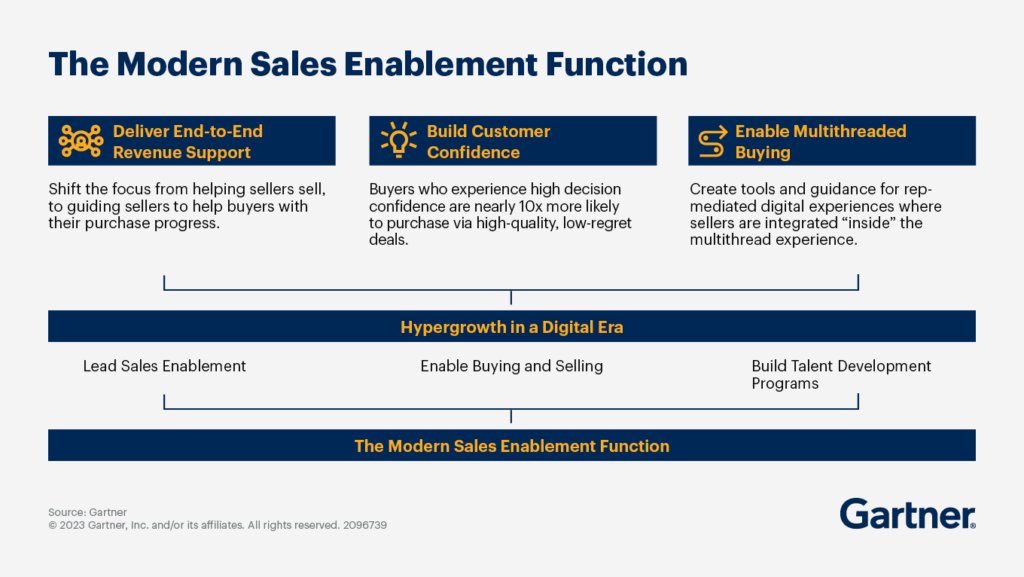Sales Enablement Isn’t a Toolkit– It’s a Mindset
Organizations often approach sales enablement as a collection of tools: a CRM platform, a content library, or a training portal. While these resources are important, they represent only one layer of enablement. A strong sales enablement strategy is a mindset that integrates people, processes, and technology to empower sales teams at every stage of the buyer journey.
When organizations adopt enablement as a mindset, they move beyond the idea of tools as quick fixes. Instead, they embed enablement into daily operations, strengthen alignment across departments, and create lasting cultural change that drives revenue performance.
Quick Takeaways
- A sales enablement strategy is not just about tools; it is a mindset that empowers teams and shapes how they engage buyers.
- Effective enablement requires collaboration across marketing, sales, and leadership to align goals and streamline execution.
- Organizations that treat enablement as a strategy achieve stronger consistency in messaging, faster onboarding, and higher win rates.
- Data-driven insights and continuous optimization ensure that enablement evolves alongside changing buyer expectations.
What Is Sales Enablement?
Sales enablement is a cross-functional discipline that equips sales teams with the tools, training, and insights they need to consistently engage buyers. It is more than a support function; it is a strategy that ensures sales teams have the right resources at the right time to close deals.
A sales enablement strategy is built on collaboration between marketing, sales, and leadership. Marketing provides relevant content, sales applies proven techniques, and leadership ensures alignment with business objectives. This combined approach creates a unified strategy that elevates seller performance and buyer experiences alike.

Why a Sales Enablement Strategy Matters
Consistency in Buyer Engagement
Enablement ensures that every sales interaction aligns with the organization’s value proposition and meets the buyer where they are in the journey. Consistent messaging builds credibility and shortens the path to purchase.
Alignment Across Teams
Sales and marketing often operate in silos, which leads to inconsistent engagement and missed opportunities. Sales enablement creates shared accountability and a single playbook, ensuring that both teams contribute to the same objectives.
Faster Ramp for New Reps
Onboarding new sales professionals can take months without proper enablement. With structured training, playbooks, and coaching, organizations reduce time-to-productivity and allow new hires to contribute to revenue faster.
Improved Win Rates
Data-driven insights from a sales enablement strategy help organizations identify the tactics, content, and messaging that resonate most with buyers. This information gives sellers confidence in their approach and increases overall win rates.
Shifting from Toolkit to Mindset
Tools as Enablers, Not the Strategy
Technology such as CRM platforms, content management systems, and training portals plays an important role in enablement, but tools alone cannot drive success. Without a clear strategy, even the best platforms go underutilized. Organizations that see enablement as a mindset prioritize how tools fit into the larger framework of training, content, and collaboration.
Building a Culture of Enablement
Sales enablement becomes most effective when it is part of organizational culture. Leadership commitment, ongoing coaching, and continuous feedback loops help sales teams see enablement as integral to their success. A culture of enablement encourages accountability, motivates sellers, and ensures that enablement evolves as business priorities change.
Core Elements of a Sales Enablement Strategy
Aligned Content Strategy
Sales enablement ensures that marketing develops content that supports the sales process at every stage of the buyer journey. This includes awareness-level educational resources, mid-funnel case studies, and late-stage ROI calculators. Making content accessible and aligned with account priorities increases the value of every interaction.
Training and Coaching
A strong enablement strategy provides ongoing training beyond initial onboarding. Coaching, role-playing, and peer collaboration allow sellers to refine their skills continuously. Organizations that prioritize ongoing development see more consistent performance and stronger relationships with buyers.
Data-Driven Insights
Analytics are central to an effective sales enablement strategy. Tracking how buyers engage with content, which tactics close deals faster, and which messages resonate most helps leaders optimize approaches. By analyzing performance data, organizations can refine playbooks and support sales teams with evidence-based strategies.
Technology Integration
Technology supports enablement by streamlining workflows and ensuring accessibility of resources. When CRM systems, sales engagement platforms, and marketing automation tools work together, sellers gain a single view of the buyer journey. Integration reduces inefficiencies and ensures sellers spend more time building relationships and less time managing systems.
Challenges in Developing a Sales Enablement Strategy
Fragmented Processes
Many organizations have scattered enablement efforts, with different teams owning parts of the process. This fragmentation leads to inconsistent experiences for both sellers and buyers. Appointing a dedicated enablement leader or team provides clear accountability and unifies efforts under a cohesive strategy.
Measuring Impact
Enablement efforts often lack clear metrics, making it difficult to prove value. Setting KPIs such as quota attainment, deal velocity, and win rate provides a measurable framework. Regularly reporting results helps stakeholders see the impact of enablement and secures ongoing investment.

Low Adoption Rates
Sales teams may resist new processes or tools if they do not see immediate value. Involving sales reps in the development of enablement resources encourages adoption by ensuring strategies reflect real-world selling challenges. Training should demonstrate how enablement makes the seller’s job easier, not harder.
Best Practices for Long-Term Success
Sales enablement delivers the greatest value when it is an ongoing discipline rather than a one-time project. Organizations should involve sales leadership and frontline reps in the design of enablement frameworks, ensuring that strategies remain practical and relevant.
Aligning enablement goals with broader business objectives guarantees that efforts support long-term growth. Regularly refreshing training, content, and playbooks ensures resources reflect current buyer needs and market conditions.
Finally, organizations should maintain a continuous feedback loop between sales and marketing. Feedback from the field helps refine content, improve messaging, and strengthen collaboration, which leads to a more unified and effective sales enablement strategy.
Elevate Your Sales Enablement Strategy
Sales enablement is not a toolkit that organizations can buy off the shelf. It is a mindset that integrates people, processes, and technology to support consistent, high-quality sales execution. By embracing it as a cultural discipline and building strategies that prioritize collaboration, training, and data-driven insights, businesses empower their sales teams to succeed in complex buyer journeys. A mindset-based approach transforms sales enablement into a driver of growth, scalability, and long-term success.
Ready to transform your sales enablement strategy into a growth mindset? Televerde helps organizations align people, processes, and technology to empower sales teams and increase revenue. Contact us to learn more.


